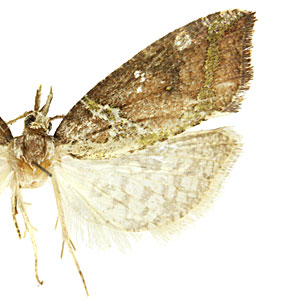Adult Recognition

FWL: 5.0-8.5 mm
Adults are tan, brown, or reddish brown with white and yellow-green markings. Labial palpi are extremely elongate in both sexes. Males have long cilia on the antennae, a hairpencil on the foreleg, and lack a forewing costal fold.
Seticosta rubicola is similar in forewing pattern to other species of Seticosta, including S. aeolozona, S. arachnogramma, S. tridens, and S. tambomachaya. Male S. rubicola can be distinguished from these other species by a pair of lateral processes near the distal end of the uncus and the lack of a dense patch of setae on the costa of the valva.
Larval Morphology

Last instar larvae are approximately 12-13 mm in length. The abdomen is brownish purple with dark, large, conspicuous pinacula. The head is black to orange with a dark lateral band and the prothoracic shield is brownish yellow to reddish brown with pale-brown mottling.
Larvae are distinguished by a combination of tortricine and olethreutine characters: SD1 and D1 on a shared pinaculum on A9; bisetose SV-group on A7; SD2 and SD1 on separate pinacula on A1-8; V setae on A9 widely separated; meso- and metathorax with extra SD, L, SV, and V setae; A1-8 with extra D and V setae; D pinacula on A2-5 notched; and L pinaculum on prothorax ventrad of the spiracle.
Biology

Adults of Seticosta rubicola have been collected in nearly every month in central Costa Rica, suggesting continuous generations throughout the year.
Larvae bore into stems and induce gall formation. Galls are fusiform, approximately 4-6 mm wide, 12-40 mm long, and are located between nodes on the terminal (young) portions of the stem. One gall contains a single larva. An opening at the base of the gall is often covered in frass and debris; this entrance hole can be detected before the stem begins to swell. Pupation most likely occurs outside of the gall.
Host plants
Seticosta rubicola feeds on Rubus and is considered a serious pest of blackberry in parts of Costa Rica. Larvae have been intercepted on Rubus arriving at U.S. ports-of-entry from Guatemala.
| Family | Genus/species | Common name |
| Rosaceae | Rubus eriocarpus Liebm. | mora (blackberry) |
| Rosaceae | Rubus vulcanicola (Donn. Sm.) Rydb. | |
| Rosaceae | Rubus L. | [various] |
Distribution

Seticosta rubicola has been reported from Costa Rica and Guatemala.
References

Brown, J. W. and K. Nishida. 2003. First record of larval endophagy in Euliini (Tortricidae): a new species of Seticosta from Costa Rica. Journal of the Lepidopterists' Society. 57: 113-120.

